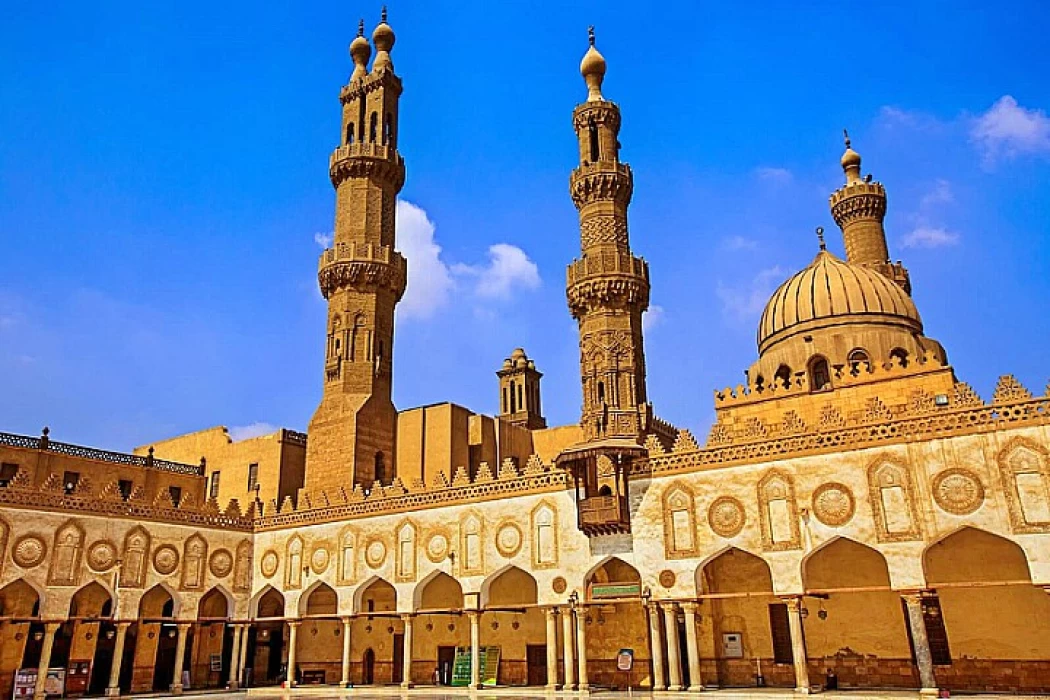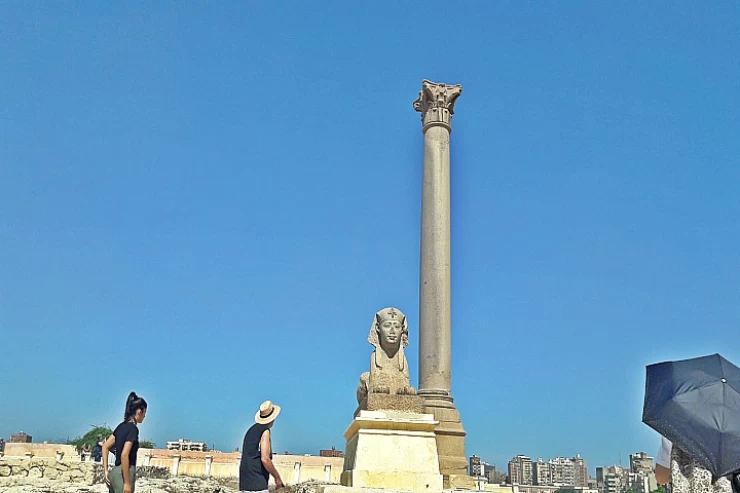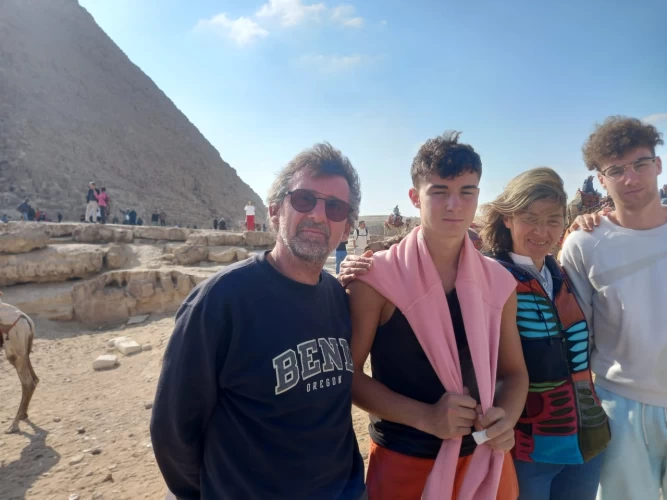
El Cairo Islámico

Un paseo por El Cairo islámico le transporta a la época en que los musulmanes gobernaban la ciudad. Las mezquitas, tiendas y mercados de esta zona se encuentran entre los más bellos de la ciudad, y un paseo por sus calles le animará a imaginar los días de gloria de la ciudad.
Aunque ya no es la zona más central del Cairo moderno, el Cairo islámico sigue siendo un recordatorio vivo del pasado de la ciudad. La mayoría de los muros fatimíes se han derrumbado durante mucho tiempo, pero hay cientos de reliquias y máscaras magníficas que aún bordean las calles históricas de Al-Qahira. El Cairo islámico es único en muchos distritos históricos porque todavía es una parte viva de la ciudad. Al-Qahira se llenó de palacios y edificios administrativos cuando se construyó inicialmente, los habitantes de El Cairo se mudaron a la ciudad amurallada durante un asedio del siglo XII y nunca se fueron desde entonces. A pesar de su arquitectura desmoronada y su infraestructura envejecida, el Cairo islámico sigue siendo una de las zonas más ocupadas de la ciudad.
Visitar el Cairo islámico puede ser una tarea imposible. Es un área bastante grande, que incluye la antigua ciudad fatimí y los distritos que se extienden hacia el sur hasta la Ciudadela de Saladin y la Mezquita de Ibn Tulun. Hay literalmente cientos de sitios de diferentes tamaños e importancia agrupados en conjunto con estos aliados estrechos. Agregue a esto el hecho de que todavía es una zona comercial y residencial ocupada y que el Cairo islámico puede presentar un gran desafío. Uno puede pasar varias semanas simplemente perdiéndose en estas calles antiguas sin quedarse sin nuevas vistas y experiencias; sin embargo, hay varias áreas en las que los turistas más informales deben centrar su atención para ver gran parte de lo que este distrito histórico tiene para ofrecer en menos tiempo.
Lo más destacado del Cairo islámico

El museo al aire libre más grande de arte islámico se llama la calle El-Moez. Esta calle fue la principal a través de la ciudad cuando se construyó durante el siglo XI y se construyeron aquí mezquitas, madrasas, sabils, mausoleos y palacios. La parte norte de la calle (entre Bab El-Fotouh y la calle Al-Azhar) se restauró recientemente. Esta es una de las partes más pintorescas de El Cairo. El Complejo Qala'un aquí es uno de los más impresionantes de El Cairo.
Tours incluyendo el Cairo islámico:
El Cairo y Crucero por el Nilo 8 dias / 7 noches
Viaje a El Cairo y Alejandría 5 Dias / 4 Noches
Tour por El Cairo al Museo Egipcio , La Ciudadel y El Mercado de Khan El Khalili
Puede pasar el día fácilmente en esta área, terminando por la noche en el famoso mercado del siglo XIV de El Cairo, Khan Al-Khalili. El trabajo de restauración en la sección sur de la calle (desde el Complejo Ghouriya hasta Bab Zuweila) comenzó en 2011. También en la zona de Khan Al-Khalili está la Mezquita Al-Azhar.
Al sur del Cairo islámico se encuentra la ciudadela de Saladin (Salah Al-Deen), que se construyó en el año 1176 dC. Hoy en día, la Ciudadela ofrece una impresionante vista panorámica de la ciudad y varios museos dedicados a la policía y el ejército de Egipto. También hay tres mezquitas famosas dentro de las paredes: la mezquita de Al-Nasir Muhammed, la mezquita de Suleyman Pasha y la mezquita de alabastro de Mohammed Ali.
Frente a la Ciudadela se encuentra el complejo masivo de Sultan Hassan, conocido como la pirámide del arquetipo islámico, y fue construido por el gobernante mameluco Al Sultan Hassan durante el siglo XIV . Esta enorme mezquita incluye una madraza (escuela religiosa para enseñar los cuatro ritos de la secta islámica en el Islam) y muestra algunos de los elementos arquitectónicos más impresionantes de cualquier mezquita en la ciudad.
El Jardín Botánico de Asuán, también conocido como la Jardines Botánicos De Asuán | Isla El Nabatat En Asuán, es un lugar genial en Asuán donde puedes aprender sobre el antiguo Egipto. Podrás imaginarte cómo era vivir allí en aquella época y ver todas las cosas increíbles que tenían.
Islamic Cairo is located in the heart of the modern metropolis of Cairo, a place of fascination with its past, culture and beliefs that have been practiced over the years. Also known as Old Cairo or Medieval Cairo, the area has been recognized and declared by UNESCO as an architectural heritage under its protection. It is home to impressive mosques, madrasas and other buildings dating back to the golden age of the Islamic Empire. For tourists, Islamic Cairo is a unique place that transports them to a time when the cries of Musasin could be heard around every corner and people's noses smelled warm spices.
go back to the seventh century when the Arab conquerors first introduced Islam into Egypt. Through the centuries, Cairo rose and became the center of the Islamic Empire under various dynasties: the Fatimids, Ayyubids, Mamluks, as well as the Ottomans. Each of these contributed and left traces of the architectural magnificence and cultural depth of the present surroundings.
Once it bloomed into its glorious days, Islamic Cairo was a thriving metropolis of commerce, schools, and temples. In the 10th century, the Fatimids moved to Egypt and made Cairo their political capital, erecting such memorable edifices as al-Azhar Mosque and the original city enclosure. Later, the Mamluks built their marvelous mosques, tombs, and madrassah structures, which embellished the city further. Even today, Islamic Cairo is still considered to be one of the least altered urban areas containing medieval Islamic architecture throughout the entire world.
When it comes to the variety of places to see in Islamic Cairo, the visitors will surely be loaded with so many sights. Here is a list of some of the landmarks that one should not miss:
1. Citadel of Salah El Din Historical Relevance: Built in the 12th century under the orders of the great Salah El Din (Tamerlane), the Citadel was constructed to protect the city of Cairo from the Crusaders’ threats.Main Characteristics of Construction: The citadel illustrates the example of military architecture of its typical medieval period, characterized by high walls and lookout points. Inside its grounds, tourists can come across the impressive Mosque of Muhammad Ali with its tilted spires and lavish decoration. Overlooking Opportunities: The Citadel is a beautiful and scenic old fortress that has an expansive view over Cairo, enabling you to see even the pyramids clearly at very far distances in good weather, which makes it ideal for taking pictures.
It was Founded in 970 AD, the Al Azhar Mosque is among the oldest universities in the world and a representation of education in Islam.
Art: The mosque is preserved as a fine architectural work of art typical of the Fatimid era. Its complex has exquisitely carved geometric shapes, stucco designs, and a beautiful marble floor. Their artworks in the form of buildings were, however, embellished by other empires, creating a mix of architectural styles under the umbrella of Islamic art.
Spirit: It’s still a religious hub and a cultural center, bringing in scholars, tourists, and other visitors from every corner of the earth. Its atmosphere is comfortable, which allows people a break from the noisy city.
Vibrant Market: Founded in the 14th century, Khan El Khalili is one of Cairo’s most famous souks (markets). A labyrinth of narrow alleys brimming with shops, it’s the perfect place to discover traditional handicrafts, jewelry, spices, and souvenirs.
Historic Tea Houses: While wandering through the bazaar, take a break at one of the historic tea houses, such as El Fishawi’s, which has been serving tea and coffee to patrons for over 200 years. This is a prime spot for people-watching and soaking in the local culture.
Artisan Workshops: Many stalls offer a peek into Cairo’s artisanal heritage, with workshops where craftsmen create intricate gold jewelry, hand-blown glassware, and colorful textiles.
4. The mosque of Sultan Hassan
The Magnificence of Construction: This mosque completed in the 14th century is an epitome of Mamluk designs. Its walls are thick and vertical, with large arches creeping along with a central courtyard enclosing an ablution area.
Center for Educational Purpose: This construction was intended to be a mosque at first and a madrassa (school) attached to it. The purpose was to train pupils in the four Sunni legal schools.
Awesome Features: The stunning mosque has marble inlay, detailed wood carving, and an imposing mihrab, which is a collection of the best works done during the Mamluk’s reign inside.
Cultural Engagements in Islamic CairoIslamic Cairo is not limited to the visit of some ancient archives and churches; it is a cultural experience. So here are some of the activities that could be part of your visit:
1. Attending a Sufi music performance at Ar-Tanura Egyptian Heritage Dance TroupeSpiritual Music: Not only is the venue located at Wekalet El Ghouri an ancient building that serves as a cultural hub, but the performance combines Sufi music and whirling dervishes that are artists performing an age-old dance of spirituality and unison with God.A Vivid Picture: All the spirituality that one associates with Islamic Cairo has easily been stripped away in the loud, festooning music, bright, glittering costumes, and the dervishes spinning around in an entrancing manner.
2. Studying Genre and Context of Islamic Art at the Museum of Islamic Art . An amazing exhibit: The Islamic Arts Museum Malaysia harbors the most extensive collection of Islamic arts ever assembled, consisting of textiles, ceramics, woodworks, and pages and documents from across the Islam dome. Explore: Objects from different Islamic empires and their cultures and achievements in arts within the Islamic world can be found.


















